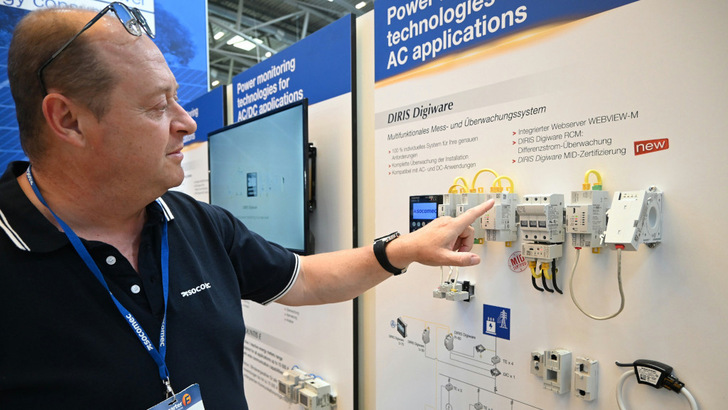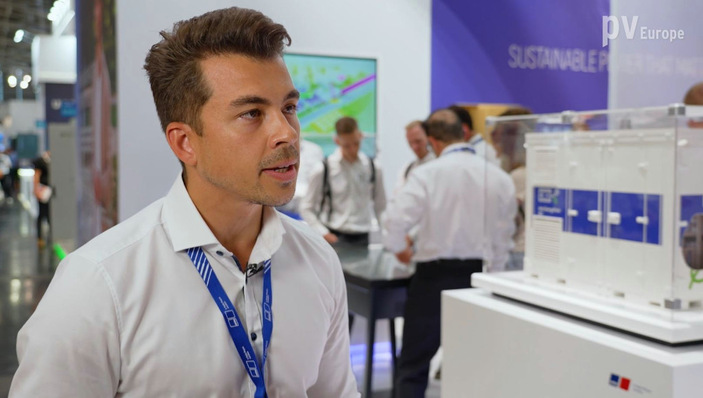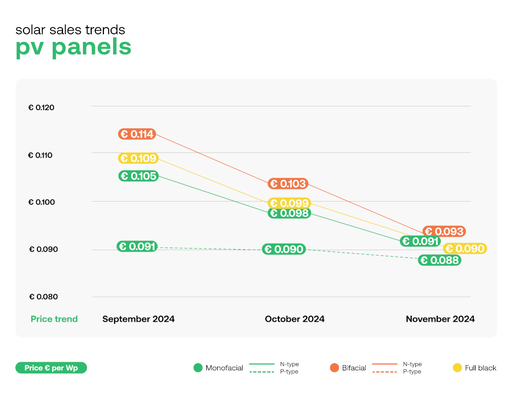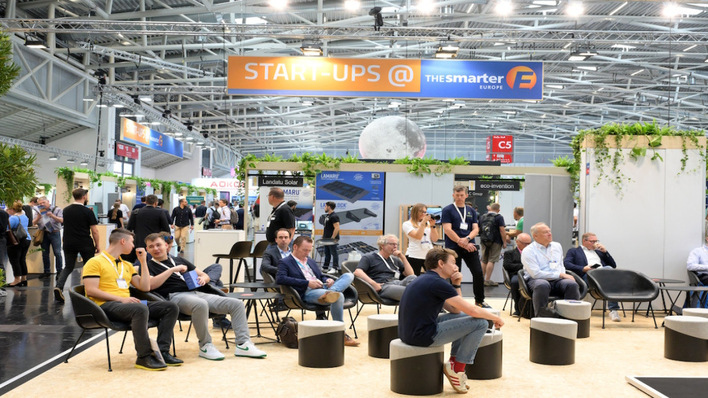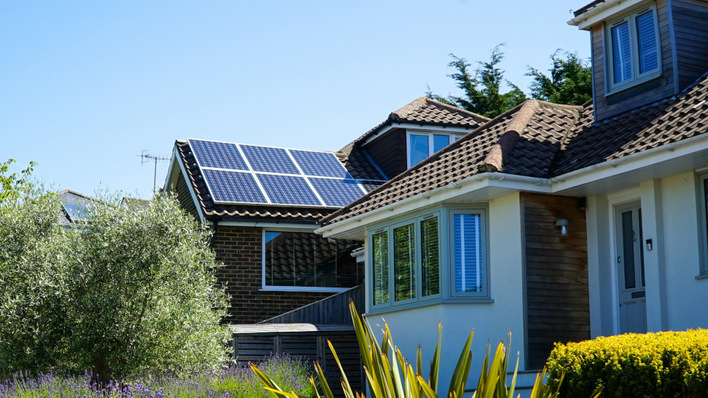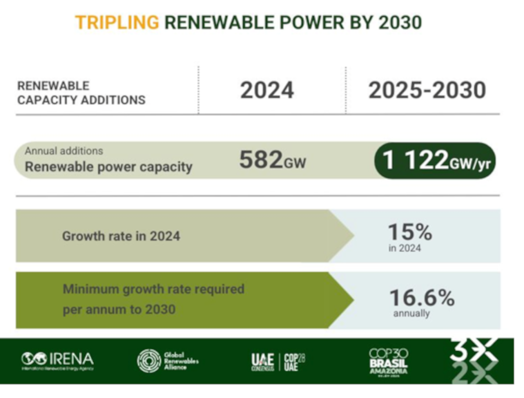How is the demand for storage units developing in the various commercial and large storage segments?
Guy Schaaf: The trend is very good. We have a lot of enquiries and are currently experiencing double-digit growth.
Which segments are doing well at Socomec?
All of the ones for which we have products. We have a lot of enquiries about building storage systems. This is mainly about storage units in the medium power range for retrofitting existing photovoltaic systems. However, we are also seeing growing demand for storage units to support the charging infrastructure for electromobility. In this area, storage units are being built so that the existing connected load does not have to be expanded.
Is that economical?
Yes, the charging infrastructure is being built next to or in buildings whose grid connection capacity is not designed for this. It would therefore actually have to be expanded or the load buffered with a storage unit. Laying new cables is very expensive. Storage units can already keep up with this in terms of price. In some cases, they are actually cheaper. This is because people often forget that we are always behind a transformer. In most cases, however, the transformers are already working at maximum capacity. If an extensive or powerful charging infrastructure is then added, the transformers have to be replaced. In such a case, the storage unit is the cheaper solution. Quite apart from the fact that the delivery times for transformers are currently extremely long and a storage unit is available much more quickly. This is why the demand in combination with charging stations and photovoltaics is huge.
See also: Trina Storage and Low Carbon build four large-scale storage facilities in the UK
And what about large storage units for the grid?
We are also realising more and more projects in this segment. It's all about grid support from the storage unit. Because this would cost a lot of money if the grid operators had to buy it. The necessary expansion of the grids is also very expensive. That's why grid operators have now reached the point where they support the grid with storage units when it is at capacity. This is also a question of feasibility. Because even if the grid operators were prepared to make the investment to expand the grid, they currently have neither the materials nor the installers to do so. Building a storage unit is much quicker.
Is the direct coupling of solar parks and storage units also an issue with the very large storage units?
I don't see very large solar parks in Germany at the moment. But that's not our target market either. In this area, we are focussing on the medium-sized solar park segment. We are seeing that more and more projects are being planned with storage units.
Which business models are relevant for commercial storage systems?
In industry, it's primarily about optimising energy costs, especially by means of peak shaving, i.e. peak load capping. In addition, the first companies are also optimising their electricity purchases with the storage unit. This means that they buy electricity when it costs little and store it. When electricity is more expensive, they use the storage and can then reduce their electricity purchases during the high-price phases. In addition to peak shaving and tariff optimisation, island or backup power functions are playing an increasingly important role for companies.
Why is this so important for companies, given the very stable grid in Germany?
It's all about security. Companies want to be completely self-sufficient for a certain period of time - at least half a day or even a whole day to safeguard processes. It's not about a quarter of an hour, but a complete power supply if something happens. In production plants in particular, the worst thing is to abruptly interrupt the process. That costs a lot of money. That's why, in the event of a power outage, companies want to complete production processes and bring them to an orderly end. If the power outage only lasts two to three hours, they can actually continue production without interruption. In this case, they use part of the storage volume exclusively to be self-sufficient during this period.
Is that more than an uninterruptible power supply - UPS?
Yes, because the UPS only takes over the critical load or critical processes. These must not be interrupted for more than a few milliseconds. The storage units are integrated into the building supply in such a way that they supply everything with power when the main connection is switched off. They can step in within 20-30 milliseconds if the power fails. This is also fast enough for critical processes.
Does the backup power supply affect the size of the storage unit?
Of course it does. But the principle is not new. It's just that it used to be done with diesel, and now companies are doing it with storage units that they can use for other purposes. Companies buy larger storage units depending on how much electricity they need for three to six hours of operation or for the orderly termination of processes. But then they always have electricity in stock in case something happens
What is the most economical way to operate a storage unit so that it pays for itself quickly?
The advantage of storage solutions is that you can influence several factors with one product. Every application brings a profit. It is therefore important to always implement as many operating concepts as possible, i.e. combinations of different functions. Each one brings some savings or profit and if you add everything up, you have very short amortisation times. In good cases, these are less than two years. Most of the projects we implement have a payback period of between two and five years. This becomes shorter the more functions of the storage unit are utilised.
Also interesting: UPS storage system for medium outputs
Do you have an example?
As a rule, it's about large consumers. Because you can save more there. We carried out a study with a data centre. This has a base load of around 1.5 megawatts. The peak load is 1.8 megawatts. However, this is mainly needed on ten to 15 very hot summer days and then only for ten to twelve hours a day. This peak load can be reduced with the installed storage solution. This reduces the required grid connection capacity. In this way, we achieve an amortisation period of two years with peak shaving alone and the optimisation of self-consumption of the self-produced solar power. The whole thing runs with an automated projection to optimise storage operation.
What business models are used to set up the large storage containers for the grid operators?
There are two options here. One is to save on grid expansion. The second option is about always having sufficient energy available. We realised a project with a grid operator in Austria. It had a lot of hydropower in its portfolio. However, hydropower is not so constant in production and there were also many peaks in consumption. The storage unit was built to stabilise this situation. The large grid storage units for peak shaving were also installed. (mfo)
The interview was conducted by Sven Ullrich.


